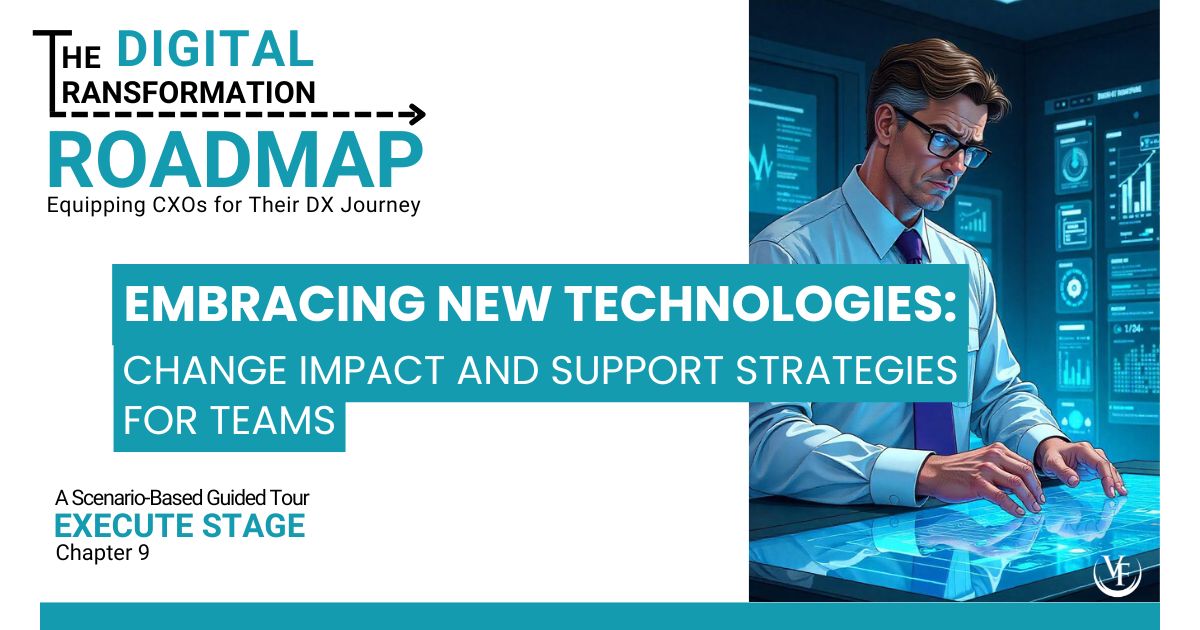
Our Execute Stage comes to life in a “scenario-based” guided tour that provides a contextual framework for DX Plan Execution. Ushering a fictional company through the process will help CXOs visualize steps in the process and identify potential challenges and opportunities on their way to plan launch.

Table of Contents:
- Chapter 1: Launching Project Pulsar: Dreams, Doubts, and Digital Transformation
- Chapter 2: Investigating Team Dynamics: Uncovering Insights for Developing an OCM Plan
- Chapter 3: Mobilizing Change Agents: A Digital Transformation’s Secret Weapon
- Chapter 4: Assessing As-Is Processes: A Critical Step in Building Requirements
- Chapter 5: Pursuing Approval for Requirements: A Battle Not Easily Won
- Chapter 6: Securing Solution Design Support From Skeptical Stakeholders
- Chapter 7: Addressing Stakeholder Misalignment and Unmet Expectations
- Chapter 8: Managing Unexpected Revelations: The Role of Iterative Design in Exposing Hidden Challenges
Galactic Gravity Inc. is undergoing a digital transformation to modernize their Virtual Reality (VR) headset manufacturing operations. Committed to long-term solutions, GGI is employing an iterative design process to achieve an optimal solution, following best practices and a proven process for transformational change.
However, it’s become increasingly evident that the proposed process changes will have a broader impact than most of the project team anticipated. As the Go-Live date approaches, Project Manager Jared Spinner realizes it’s time for proactive measures to prepare the organization for the upgrades. With rising risks such as scope creep, change resistance and communication blockages, Jared enlists the support of Organizational Change Management (OCM) Lead Erin Torres for additional reinforcement.
Watch this short video with DX Roadmap creator Camilla Richter and Victoria Fide CEO Tory Bjorklund as they discuss some common challenges faced by companies when integrating new technology.
Monitoring Risks Across a Large Digital Transformation
“I can’t tell if Jonathon really does know all the processes in and out, or if he just thinks he does,” the Solution Architect Jesse Bowman confided in Jared. “Every time I’ve asked him to bring Marie or another SME, he says he’ll ask them, but then he shows up empty-handed, saying there was a conflict. I don’t want to keep postponing the design sessions, so we’ve been continuing on, but I’m getting worried that Barry and I aren’t getting all the information we need to build a solution.”
“Given that Production is a primary focus in this project, I agree this is concerning,” Jared frowned. “I don’t doubt Jonathon’s good intentions and solid knowledge of the business processes, but excluding others from his team is a big risk, intentional or not.”
“Yeah, and one that could come back to bite us later on down the road,” Jesse added, running his fingers through his silver hair.
“Thanks for bringing this to my attention, Jesse. I’ll record this as a risk and reach out to Jonathon and see what’s going on and if we can involve more of his team moving forward.”
Jesse thanked him.
“Before you go, I’ve noticed a surge of additional requirements particularly from the Warehouse team. While we want to collect feedback and ideas, we need to be careful to avoid scope creep. Can you set up a meeting between us and Barry to discuss how to consistently message the consideration of additional requested functionality?”
Jesse nodded. “I’ve noticed that as well. They struggled to provide very much documentation up front, so Barry and I have been working hard to sift through tribal knowledge to get at the true requirements.”
“Yes, that’s unfortunate,” Jared mused. “I appreciate all the work you two have been putting in. While we don’t want to throw a wet blanket on the enthusiasm for the project and more efficient business processes, it’s important to distinguish between essential needs and nice-to-haves. Frankly, we don’t have the time or the budget to continue making adjustments and adding unplanned development.”
“I understand,” Jesse nodded.
“I think it’s also important for the team to consider that once we go live, we may not even need some of the nice-to-haves. We’ll have a better picture of their benefits after we begin executing the new business processes and then can reassess.”
“Agreed. I’ll get that meeting set up and we can confirm the messaging for this.”
Once Jesse left, Jared finished entering the details in the risk register and sighed. The project was on track at the moment, but these new risks could quickly derail the whole initiative. Before reaching out to Jonathon, Jared knew he’d need some help with how to approach the Production Manager in a way that wouldn’t agitate him or devalue his expertise. Thankfully, he knew just the person to help.

Transformation is not easy, but it doesn’t have to be impossible. Take control of your project’s success today and schedule a free 30-minute consultation to find out how Victoria Fide can equip you for transformational success.
Strategies for Encouraging Team Participation in Design Sessions
“Hi there,” Erin Torres looked up and smiled over the monitor on her desk. “What can I do for you?” The Organizational Change Management (OCM) lead’s positive energy lifted Jared’s mood simply by being in the same room.
“I’ve got a bit of a situation I’d like your expert opinion on,” Jared said, settling into the chair across from her. He quickly summarized the conversation between himself and Jesse, emphasizing the importance of gaining multiple perspectives from the production team in order to build a well-rounded and effective solution. “My problem is, I don’t know the best way to approach him without coming across as combative or accusatory, but I also need him to understand the importance of allowing and encouraging other voices in this process, not just his.”
Erin listened intently, nodding and jotting down notes here and there but otherwise letting him speak. When he finished speaking, she remained quiet for a moment, contemplating what he’d shared. Finally, she spoke. “What has Marie’s involvement been so far?”
“The change agent? I know she hasn’t been participating in the design sessions, but I believe she and Jonathon meet on a regular basis. How much input is being gathered or information shared in those meetings remains a mystery, though.”
“Marie was singled out as a powerful change agent because of her relationship with her team,” Erin reminded him. “She could be the missing link in this scenario. Her job is to build trust, advocate for the team, and alleviate their anxiety with the new processes. The goal will be for her to join the remaining design sessions. If she can’t be there for the entire session, having her present for even half of it would be beneficial.”
Jared nodded. “That sounds good. I can talk to Jonathon and Marie about that moving forward.”
“As far as bringing it up in a way that won’t aggravate him,” Erin continued thoughtfully. “I would suggest leading with curiosity. We don’t know his motives for keeping his team out of the design sessions, so let’s not assume we do. Broach the topic, explain your concerns, and then leave it open for him to share his perspective. He might surprise you!”
Jared thought about this for a moment, nodding slowly as he considered the possibilities. “I can do that,” he said.
“And if you try that and still need support, I’d be happy to sit in on a meeting with the Production team and see what I can do to help,” Erin added with a warm smile.
“I appreciate that Erin, thanks.”
“Of course!”
Integrating New Technology: Training and Support Strategies
Jared moved to stand up, but Erin stopped him. “Do you have a few extra minutes?” she asked. “I meant to reach out later this week, but since I have you here…”
“Absolutely,” Jared nodded, settling back into his chair. “How can I help?”
“From what Jesse and Barry have told me, it seems that the proposed process changes are going to have a broader impact than we originally anticipated… I think we need to revisit our change management plan to make sure the team really understands what the changes will entail and how best to plan for it.”
Erin went on to explain she had been working through a list of changes to identify potential resistant points. Jared was impressed to note that the information had been grouped by workflow and related roles.
“I have some ideas on how to decrease resistance to these changes and would be happy to discuss them with the rest of the project team. Specifically, regarding the use of handheld scanners in the warehouse…”
Jared cocked his head. “Is there a problem with the scanners?”
“I’ve been told the warehouse team is a bit apprehensive of the new technology,” Erin explained. “We need to reassure the users that we will be providing additional training for the devices, as well as ongoing device support from the IT team.”
“We can do that,” Jared nodded.
“I have some recommendations for the additional training I will share with you before the end of the week based on the information Jesse has provided.”
“Perfect,” Jared smiled. “I can also make sure to have spare devices on hand if needed. We have plans to install Wi-fi range extenders in the warehouse next month. If you want, I can work with you to update our testing plan to include additional user acceptance testing once the extenders are installed.”
“That sounds great, thank you!” Erin smiled warmly.
“Of course. Thank you for bringing this to my attention, Erin.”

Transformational Success through Teamwork and Preparation
Thanks to Erin’s recommendations, Jared’s meeting with Jonathon and Marie went without a hitch. As Erin suggested, Jared was surprised by Jonathon’s motives to not include his team. It turns out the production manager was just doing his best to protect the extremely small margin of time his team had, as they were all stretched thin with the demanding orders. But once Jared expressed the real concerns, Jonathon agreed to reconsider. With Jonathon on board and Marie using her creative problem-solving skills, they were able to form a plan to include Marie in all future sessions, much to Marie’s excitement.
As Jared turned the page to address the next risk within the warehousing team, he was reminded once again of the importance of preparation. Proper preparation went much deeper than a well-constructed project plan; it was about preparing and equipping the teams to not only handle the changes, but also embrace and thrive in them. Thanks to Erin’s recommendations, they would be able to help the warehouse team plan for a successful transition while building user’s confidence in the new devices.
If you’re planning a digital transformation or currently undertaking a transformative initiative, don’t forget to subscribe and follow along as GGI uses Victoria Fide’s Process for Transformational Change to transform their company, optimize their processes and scale for international growth.
Subscribe to our weekly LinkedIn Digital Transformation Success newsletter and get notified of each new edition.
